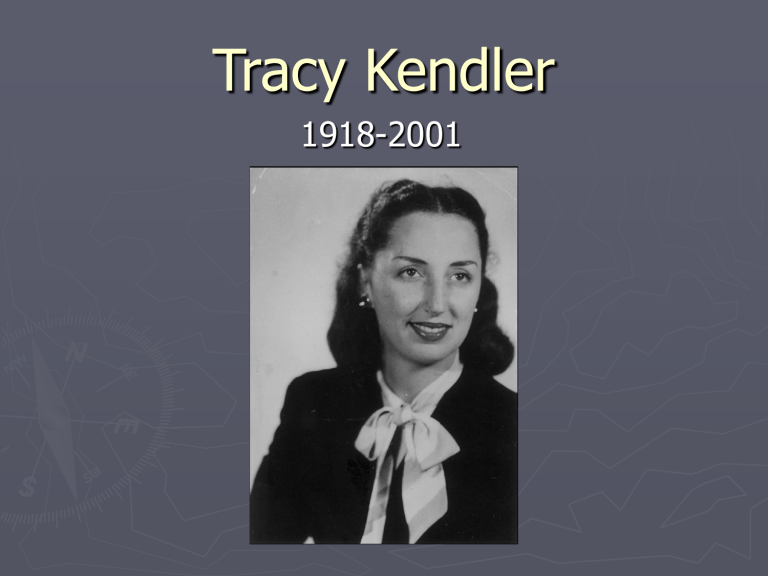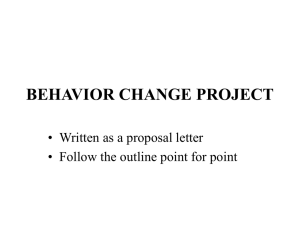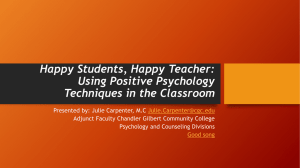Tracy Kendler - University of Tulsa

Tracy Kendler
1918-2001
Introduction
Did it all:
►
Jewish Psychologist
►
Researcher
►
Professor
►
Wife
►
Mother of two sons
Family
►
►
►
►
►
Parents never went beyond an elementary education
They had to work
Worked all of time throughout Tracy’s childhood
Financial hardship
Tracy took care of herself
Said this caused her to “develop an independent streak that later stood me in good stead”
Her father died when she was 8 years old
Mother remarried and had her half-sister
Tracy helped take care of her sister
Name Change
►
Tracy born with the first name Sylvia
►
She worked at a summer camp for preschoolers
4 out of the 5 counselors were named Sylvia
►
Tracy had just seen “The Philadelphia Story”
A romantic comedy movie
The main character’s name is Tracy
►
Decided to change her name to Tracy
Later it was changed legally
Developmental Psychologist
►
Researched development within a neobehavioristic then cognitive orientation
► Researched and wrote many articles with her husband, Howard Kendler
► Howard was supportive of Tracy and treated her as an equal
The unfair treatment of her angered him
Historical Antecedents
“To be born in interesting times is said to be a curse. Looking back now, I find the interest generated overshadowed the discord experienced.”
– Tracy Kendler in her autobiography “A
Woman’s Struggle in Academic Psychology
(1936-2001)”
Historical Antecedents cont.
► Anti-Semitism
Parents emigrated to U.S. from Eastern Europe
(Hungary and Russia) to escape anti-Semitism
Especially prevalent throughout Kendler’s early years, adolescence, and college years
► WWI
Tracy born during the end of it in New York City in 1918
Historical Antecedents cont.
► The Great Depression
She was 11 years old when stock market crashed
Italian Fascism and German Nazism on the rise
Communist ideology becoming prevalent in NY intellectuals
Political and social interest in her neighborhood, Coney
Island (childhood), Brighton Beach (adolescence)
Tracy became a student political activist in high school
Everyone had financial problems including Tracy’s family
Historical Antecedents cont.
WWII (1939)
Tracy was…
►
18 yrs. old when Hitler came to power in Germany
►
21 yrs. old when war started
Historical Antecedents cont.
► Status of Women in psychology leading up to Tracy’s time:
Very few compared to number of men
Difficult (sometimes impossible) to get into graduate school for psychology
No jobs in psychology for women (could not be professors)
Most psychologists considered women inferior to men
Historical Antecedents cont.
Developmental Psychology:
► Began from academic interest for the betterment of children
The use of scientific methods for social purposes
► The Iowa Child Welfare Research Station
In 1906 a woman who had lost some of her children worked with the University of Iowa and legislators to start it (began in 1917)
Devoted to research in child development (their physical and educational well-being)
Developmental Psychology cont.
► The Iowa Child Welfare Research Station cont.
Bird Baldwin started the Preschool Laboratories part of it in 1925
Began doing research in naturalistic settings in 1930s
(Stoddard, Skeels, Wellman, Updegraff) and found unstimulating environments can cause a loss of IQ in children (1938)
► Experimental Child Psychology: 1950s and 1960s
Using children as subjects to test general psychological theories for the purpose of extending scientific knowledge
Charles Spiker established the first graduate program
Historical Antecedents cont.
Gestalt Psychology
► Founder considered to be Max Wertheimer (1880-1943) in
Germany
► Other important influences: Koffka, Kohler (Wertheimer’s students), Lewin, Perls (founded Gestalt therapy)
► Emphasis on the whole
► Our consciousness and behavior occurs within a perceptual field
►
Phenomenology: A technique used by Gestaltists; is the study of that which naturally appears in consciousness
Historical Antecedents cont.
► Solomon Asch
Became a distinguished social psychologist
Taught Tracy’s experimental psychology course during her undergraduate studies
Taught Gestalt theory
Convinced Tracy (and Howard Kendler, her future husband) to go to graduate school in psychology at the University of Iowa to study with Gestaltist Kurt Lewin
Historical Antecedents cont.
► Neobehaviorism
Neobehaviorist that converted Tracy from Gestalt psychology to neobehaviorism: Kenneth Spence
Tested elaborate, associative theories about the learning process
Mental processes can be inferred from behavior but they are not publicly observable
Focus on S-R and everything besides the S that impacted the R
Attempted to find lawful relationships to explain behavior
Zeitgeist
► Thomas Kuhn
At the time, he was researching children’s discrimination learning and how it differed from animals.
The Kendlers’ started researching behavior in rats, but when they saw other experimenters using children, they then veered more toward studying children’s behavior.
► Science was moving toward a more concrete pragmatic approach and concentrating less on theory
Zeitgeist cont.
►
Role of women in science
“Most important social influence”
Academic Psychology (257).
A Woman’s Struggle in
Called herself an antediluvian feminist—a feminist before the feminist movement
All of the male graduate students in psychology had research or teaching assistantships. Tracy never did.
First woman Kenneth Spence sponsored.
►
Shortly after marrying Howard, Spence told her to concentrate on being a “good wife.”
►
Several years later, he changed his mind about women in science.
Zeitgeist cont.
►
Kurt Lewin
Sought to extend Gestalt theory to the fields of personality and social behavior
Member of the Child Welfare Research
Station
Along with Spence, applied their theories
(Gestalt and Neobehaviorism) in their research with children and this started basic, as opposed to applied, experimental child psychology.
Zeitgeist cont.
► Kurt Lewin
His life space model: interacting forces operate to determine the person’s behavior, the personenvironment interaction is a
“life space”; this model did not survive
Much of his research was done on children, but the experiments were intended to test, articulate, and extend a general theory of behavior.
Zeitgeist cont.
►
Kenneth Spence
Neobehaviorist—sought to convert Gestaltists
Early in career, produced an influential theory about discrimination learning in animals then tested it on children and found similar learning principles in children.
Opened the door to graduate school for Tracy, converted her to neobehaviorism
A step in achieving the goal of neobehaviorism was to make “ directly observable behavior ” the subject matter instead of the intangible mind. Mental processes can be inferred from behavior, but not publicly observable— A
Woman’s Struggle in Academic Psychology (256).
Zeitgeist cont.
►
Kenneth Spence cont.
Tracy was so intrigued by
Spence that she chose to do her
PhD thesis with him. This thesis involved his theory mentioned earlier.
Doctoral research focused on discrimination-learning with white rats. Thesis was designed to test a set of predictions that would pit
Spence’s mathematical model of discrimination-learning against
Gestalt theory.
Howard and Tracy admired
Spence so much, they named their second child, Kenneth, after him.
Zeitgeist cont.
►
WWII
Japan bombed Pearl
Harbor on December 7,
1941 when Tracy was in her second year of graduate school—the
US entered the war.
Professional struggles/obstacles
►
Great Depression
Tracy did not have enough money to go to college immediately after graduating high school because her family had financial problems.
►
Family
Mother opposed to her going to college. She thought she should find a “wealthy husband” instead— A Woman’s Struggle in Academic
Psychology (256).
Professional struggles/obstacles cont.
►
Anti-Semitism
When going to register for classes, Tracy was told that the courses she wanted to take were closed—partly because she was a woman and partly because she was a Jew. When Kurt Lewin (a
Jew himself) learned about the unfriendly welcome
Tracy and Howard received he was furious.
Professional struggles/obstacles cont.
►
Lack of respect for women in education
When being interviewed by the head of the psychology department at the University of Iowa, John McGeoch,
Tracy was told that there were no jobs for women.
After obtaining her PhD, the only job Tracy could find was as a clinical psychologist at the Chicago State
Hospital—a hospital for the seriously disturbed and
“insane.”
Finally offered a graduate assistantship to teach experimental psychology at Barnard College 11 years after obtaining her PhD.
Professional struggles/obstacles cont.
► Lack of respect for women in education cont.
Applied for a faculty position in Child and Adolescent
Development at Barnard College, but the Chairman of the Psychology Department told her that he “had an application from a male psychologist whom…would be hired, not because he had a superior record but because he would not have the divided responsibilities of a married woman with children” as she would— A
Woman’s Struggle in Academic Psychology (260).
Tracy wanted to do graduate teaching at Columbia
University, but at the time there were no women psychologists in the psychology department at
Columbia.
Professional struggles/obstacles cont.
► Lack of respect of women in education cont.
Finally obtained an assistant professor position at
Barnard College 12 years after receiving her PhD—the man declined the position in Child and Adolescent
Development that she had also applied for.
Always offered lower level job positions and less salary than Howard despite the fact that both had same qualifications and concentrated their research on the same subject matter.
The University Faculty Club at Columbia University
(Barnard College is the partnering women’s college) even excluded women, unless they were granted with the honor of being a guest of a male to the restaurant on the top floor.
Kendler’s Work
►
Discrimination learning
Subject reinforced to respond to certain characteristics of stimuli (size, shape, etc.)
Shifts
►
Reversal shift
►
Extradimensional shift
Shift Behavior by Developmental
Level
►
“An Ontogeny of Optional Shift Behavior” in the journal
Child Development
in 1970
Studied differences in shift behavior among kindergarteners, second graders, sixth graders, and college students
Found that the ease of making a reversal shift increases with age
But the ease of making an extradimensional shift declines with age
Cognition
►
Mediation theory
A way of defining what goes on internally between stimulus and response
Early “cognitive revolution”
Originally an abstract Gestalt concept
Through her work, Kendler tried to make it something observable (neobehaviorist)
Strengths/Weaknesses
►
Beginning of cognition
►
Mediation theory relied too much on external stimuli and didn’t explain the consistency of cognition
Was supplanted by a more cognitive,
“interactionist” approach (Piaget)
Influence of Tracy Kendler
► Many accomplishments in psychology despite being a minority and a woman and living through many struggles
Published more than 60 articles and 1 book in the areas of learning and developmental psychology
Levels of Cognitive Development (1995): Pointed to cognitive psychology and neuroscience as the future for understanding developmental changes in cognitive functioning
Basic Psychology: Brief Edition : Textbook for general psychology classes she wrote with her husband
Influence of Tracy Kendler
►
►
►
►
►
►
►
Recipient of a Guggenheim Fellowship
One of the 1st women members of the Society of
Experimental Psychologists
1st woman member of the Governing Board of the
Psychonomic Society
President of the Western Psychological Association in 1977
Consulting editor for Child Development
Long-term member of the Society for Research in Child
Development
Received several National Science Foundation grants and a
United States Public Health Service grant to fund her research
Influence of Tracy Kendler
► Helped change the minds of male psychologists to be more favorable toward having women in the field especially Kenneth Spence
PhD thesis judged to be excellent
Received PhD in 1943
Successful in research and became a professor despite obstacles
Endured unfair treatment for being a Jew and being a woman in psychology
Influence of Tracy Kendler
► Worked against prejudice not only for those who were Jewish but also for African Americans
Worked for the Commission for Community Relations, a branch of the American Jewish Congress (AJC), which did research on social prejudice
Worked with AJC in combination with the NAACP to collect and interpret evidence relevant to the problem of whether segregated schools can provide equally effective education
Influence of Tracy Kendler
► Wrote “Contributions of the Psychologist to
Constitutional Law” (1950)
A report against the “separate but equal” principle based on her research findings
May have contributed to the principle being overturned in Brown v. Board of Education of Topeka, Kansas
(1954)
► Made significant contributions to understanding learning and development
“Vertical and horizontal processes in problem solving”
Identified as a Citation Classic by Current Contents
Was cited over 337 times between 1963 and 1976
Influence of Tracy Kendler
Applied a cognitive-behavioral approach to the study of learning and problem solving
Research on cognitive development helped progress developmental psychology
► Mentor to graduate students
Very important to her
She called it a “peak experience” to have graduate students help with her research
Influence of Tracy Kendler
► Family and career
Had a professional career
Still put her husband and children first
Son, Kenneth Kendler, recently awarded the distinguished Lieber Prize for outstanding research in human genetics, which he dedicated to his loving parents
Influence of Tracy Kendler
Dedicated her book to her husband:
“To...my husband Howard Kendler, I am indebted for putting up with me all these years without losing his sense of humor. He encouraged me to begin this line of research and we collaborated on all the early experiments as well as on the early theorizing.
Although the scientific collaboration eventually ended, he remains my best friend and dearest companion, as well as my severest critic.”
Tracy Kendler died of pulmonary fibrosis on July 28, 2001 with
Howard at her side
Summary: Who was listening???
1.
2.
3.
What type of psychology did Tracy Kendler focus on?
a.
Neobehaviorism
Who were some of the well-known psychologists who influenced Tracy?
a.
Solomon Asch b.
Abraham Maslow c.
Kurt Lewin d.
Kenneth Spence
What were some of Tracy’s main areas of experimentation and research?
a.
Discrimination learning b.
Mediation theory
Summary cont.
4.
5.
What were some of the obstacles that Tracy had to overcome?
a.
Being a female in a time that women were not well-respected b.
Being a Jew during WWII and the aftermath of WWII c.
Mother not wanting her to go to college—instead look for a nice husband d.
Great Depression: did not have enough money to enter college upon graduation of high school
Besides being an advocate for her own minority group, what other minority group did she fight for the rights of?
a.
African Americans
References
Basden, B. H. (2002). Tracy Seedman Kendler (1918-2001). American Psychologist
Kendler, H. H. (2002). A personal encounter with psychology (1937-2002).
, 57
History of
, 364.
Psychology , 5 , 52-84.
Kendler, H. H., & Kendler, T. S. (1962). Vertical and horizontal processes in problem solving.
Psychological Review , 69 , 1-16.
Kendler, H. H., & Kendler, T. S. (1971). Basic psychology: Brief edition. East Norwalk, CT:
Appleton-Century-Crofts.
Kendler, T. S. (1950). Contributions of the psychologist to constitutional law. American
Psychologist , 5 , 505-510.
Kendler, T. S. (1991). The development of developmental psychology. In Joan H. (Ed.).
Psychology at Iowa: Centennial essays. Hillsdale, NJ: Lawrence Earlbaum Associates.
Kendler, T. S. (1995). Levels of cognitive development. Hillsdale, NJ: Lawrence Erlbaum
Associates.
Kendler, T. S., & Kendler, H. H. (2003). A woman’s struggle in academic psychology (1936-
2001). History of Psychology
Suppes, P. (1975). From behaviorism to neobehaviorism.
Thousand Oaks, CA: Sage.
, 6 , 251-266.
Theory and Decision , 6 , 269-285.
Woldt, A. L., & Toman, S. M. (Eds.). (2005). Gestalt therapy: History, theory, and practice.







